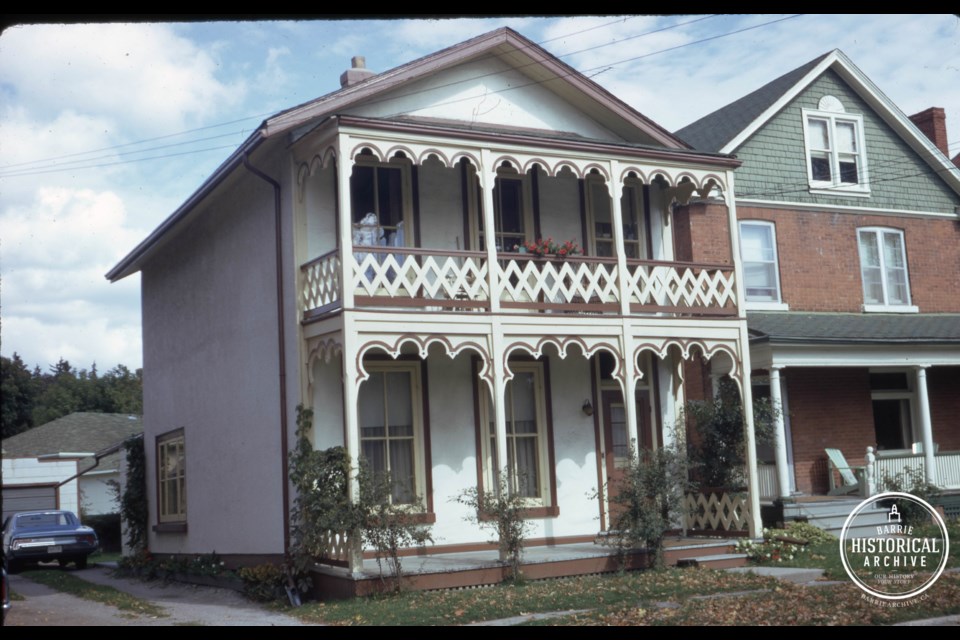This ongoing series from Barrie Historical Archive curator Deb Exel shows old photos from the collection and one from the present day, as well as the story behind them.
30 McDonald St.
Referred to as McDonald Street since about 1854, the street was originally named from Lt.-Col. Robert McDouall. The street suffered through many spelling variations before arriving at the accepted name used today.
McDouall was born in 1774 in Stranraer, Scotland. He began his career in 1797 as an ensign, seeing service in Egypt, Copenhagen and Martinique before coming to Lower Canada in 1810.
During the War of 1812, he served under Gov. Sir George Prevost and was promoted to major in the Glengarry Light Infantry Fencibles in 1813. Only a month later, McDouall was promoted again to brevet lieutenant-colonel and made commander of an important military and trading post captured from the U.S. in 1812 — Michilimackinac (Mackinac Island).
McDouall, 10 officers and 200 men of the Glengarry Light Officers, along with 20 sailors and 20 artillerymen, set out from Kingston in 1814 to relieve the garrison at Michilimackinac, near Sault Ste. Marie. When they reached York (Toronto), they headed up Yonge Street to Kempenfelt Bay. They travelled the Nine Mile Portage to connect with the advance team building the boats that would be used to reach the island.
The challenging spring crossing took almost a month and, later that summer, McDouall defended Michilimackinac from the American forces, keeping the fort in British control until the Treaty of Ghent the following year returned it to the U.S.
McDouall went on to command the garrison at Drummond Island until 1816, when he returned to Scotland. He was made a Companion of the Order of the Bath the following year in recognition of his service at Michilimackinac.
Although McDouall never saw active duty once he returned to Scotland, he was promoted to the rank of brevet colonel in 1830 and major general in 1841. He died a bachelor in his native Stranraer in 1848.
So it’s unfortunate the street intended to honour this distinguished officer does not actually bear his name.
The house at 30 McDonald St., lcoated near the city's downtown library branch, once looked onto the H-Block, an area in 1833 described as a meadow surrounding a shallow pool. It was owned by Alexander Walker, Barrie’s first permanent settler, who had come to Barrie to work on the Nile Mile Portage to Willow Creek, as a teamster, about 1825.
By the 1840s, the demand for building lots in Barrie was growing and owners of large tracts of land began dividing their property into lots. In the late 1850s, council demanded the ‘swamp’ (pond) at McDonald and Sophia streets be drained and the land developed. This section of land bounded by Owen, Worsley, Clapperton and McDonald streets, owned by J. Edwards, was resurveyed into a new plan of lots and laneways.
‘Edward’s Plan’ created an H-pattern subdivision, the H-Block — a downtown neighbourhood. Within the block, the lots facing Worsley and McDonald streets were twice as deep as the lots facing Owen and Clapperton streets — these options of smaller properties made ownership more affordable to tradespeople and labourers.
The design of the H-Block was such that residents could have a small yard and share common spaces along the laneways where outbuildings could be built.
The H-Block was a mixture of building styles: Many of the homes were roughcast single- or one-and-a-half-storey dwellings, with a few brick homes and a number of wooden shanties. The little downtown neighbourhood would be home to many working-class families and was filled with vegetable patches, flower gardens and an apple orchard.
Like many of its neighbours in the H-Block, 30 McDonald was a ‘plastered with lime mortar,’ one-and-a-half-storey, gable-end dwelling, a design that fit the narrow lots in the area. Roughcast houses were common around town and generally nondescript in appearance. Such would be the case with 30 McDonald St., except for the whimsical woodwork and two-storey veranda at the front of the house.
The house had been built about 1875 for D.B. Garton. David Bassingdale Garton was married to Sarah Jane Lang, daughter of Alex Lang, governor of the Simcoe County Jail.
D.B. had once owned a lumber yard, but may be better remembered for Garton’s Photographic Gallery on Dunlop Street. His shop, equipment and service were self-proclaimed to be unrivalled and he sold photo albums, cases and lockets for excellent prices.
By 1881, he had switched careers and became a pump maker and, by 1901, the Gartons had relocated to Toronto.
Records indicate one of the occupants of 30 McDonald after the Garton family was Mary Freek, a dressmaker and sister to William Freek, who operated a brick yard at the corner of Mary and Sophia streets. Mary Freek moved to Toronto in 1912.
For decades, the home belonged to William and Evangeline Graham, who were joined by their daughter, Pearl, a milliner, and her husband, Thomas Burton, an electrician.
The view from the verandahs of 30 McDonald St. would change. By the late 1970s, the condition of some of the H-Block buildings had deteriorated. It remained a downtown neighbourhood until the 1980s, when, after a number of development projects fell through, the city had the buildings demolished.
The H-Block sat vacant until 1996, when the new Barrie Public Library was built.



